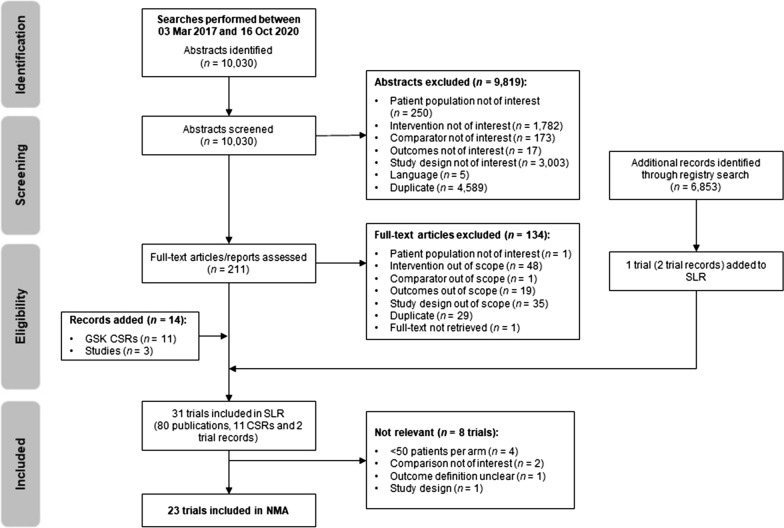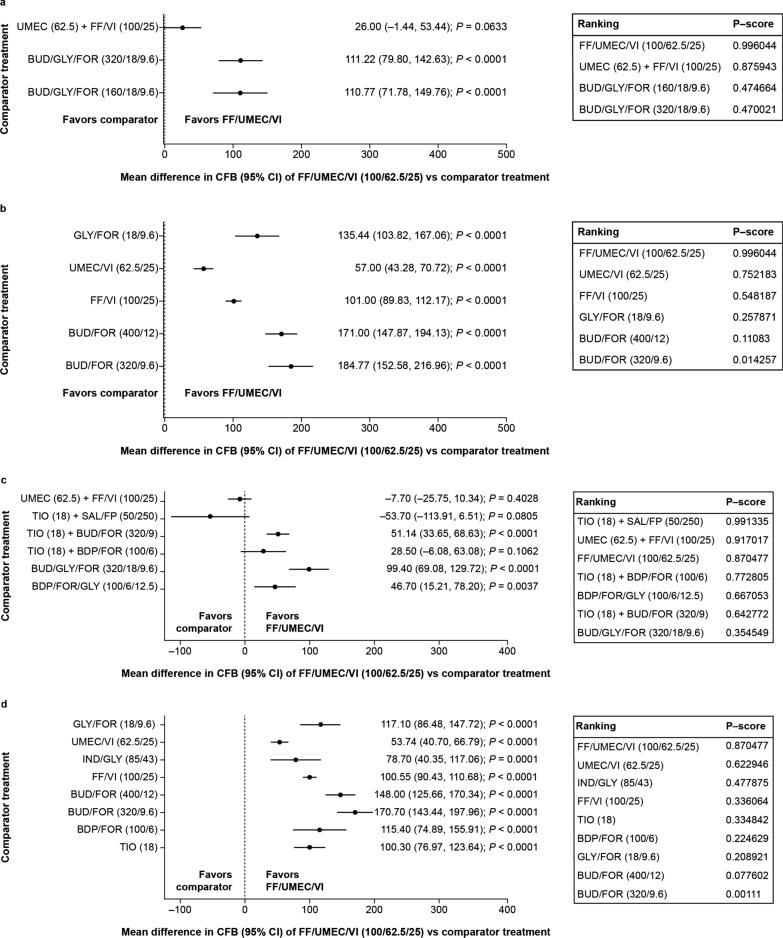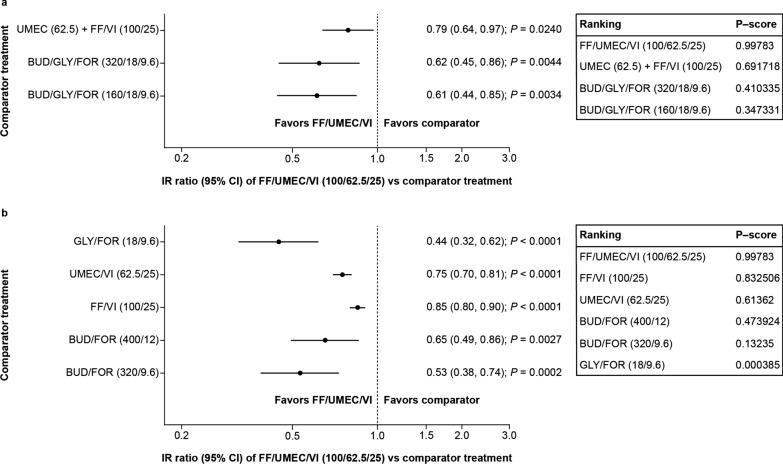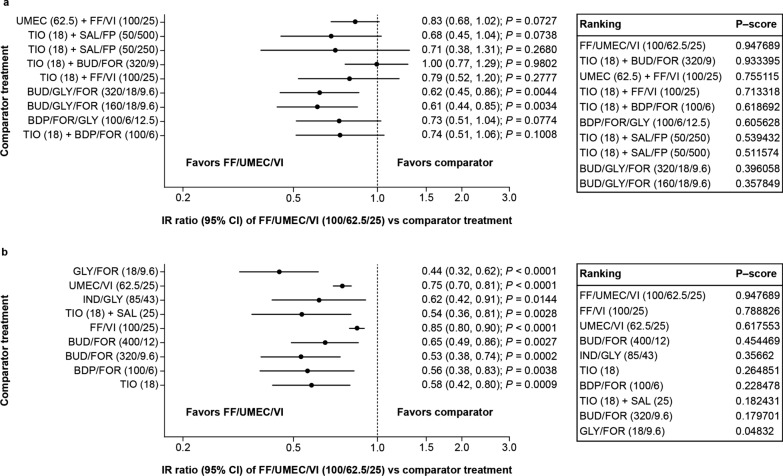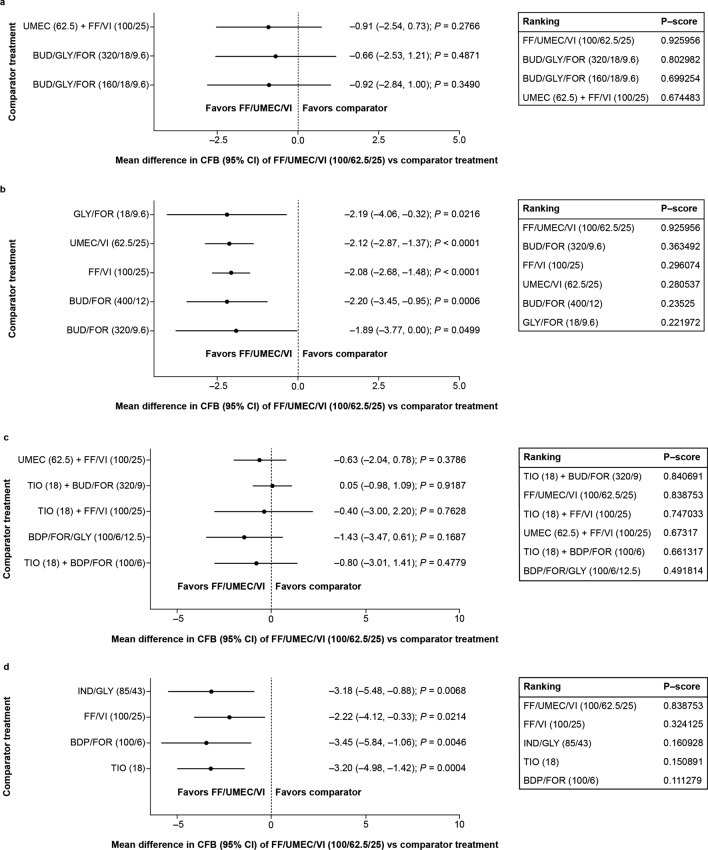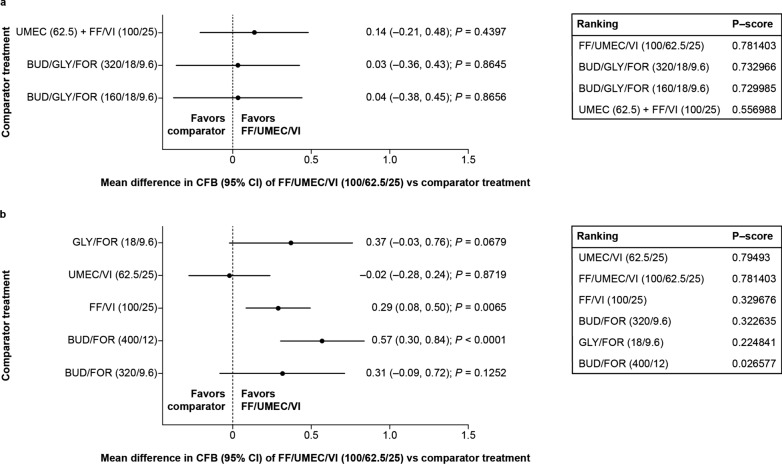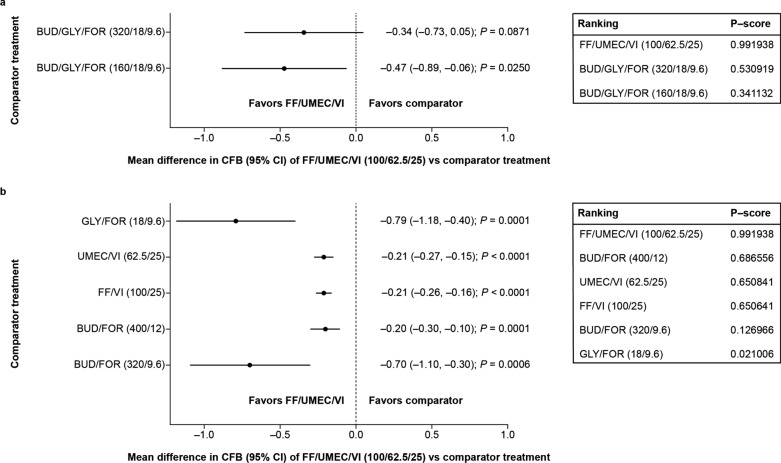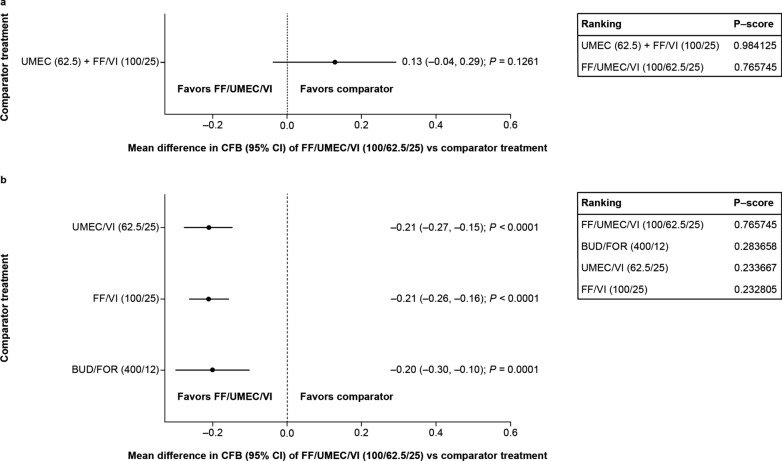Abstract
Introduction
Randomized controlled trials (RCTs) comparing triple therapies (inhaled corticosteroid [ICS], long-acting β2-agonist [LABA], and long-acting muscarinic antagonist [LAMA]) for the treatment of chronic obstructive pulmonary disease (COPD) are limited. This network meta-analysis (NMA) investigated the comparative efficacy of single-inhaler fluticasone furoate/umeclidinium/vilanterol (FF/UMEC/VI) versus any triple (ICS/LABA/LAMA) combinations and dual therapies in patients with COPD.
Methods
This NMA was conducted on the basis of a systematic literature review (SLR), which identified RCTs in adults aged at least 40 years with COPD. The RCTs compared different ICS/LABA/LAMA combinations or an ICS/LABA/LAMA combination with any dual therapy (ICS/LABA or LAMA/LABA). Outcomes of interest included forced expiratory volume in 1 s (FEV1), annualized rate of combined moderate and severe exacerbations, St George’s Respiratory Questionnaire (SGRQ) total score and SGRQ responders, transition dyspnea index focal score, and rescue medication use (RMU). Analyses were conducted at 24 weeks (primary endpoint), and 12 and 52 weeks (if feasible).
Results
The NMA was informed by five trials reporting FEV1 at 24 weeks. FF/UMEC/VI was statistically significantly more effective at increasing trough FEV1 (based on change from baseline) than all triple comparators in the network apart from UMEC + FF/VI. The NMA was informed by 17 trials reporting moderate or severe exacerbation endpoints. FF/UMEC/VI demonstrated statistically significant improvements in annualized rate of combined moderate or severe exacerbations versus single-inhaler budesonide/glycopyrronium bromide/formoterol fumarate (BUD/GLY/FOR). At 24 weeks, the NMA was informed by five trials. FF/UMEC/VI showed statistically significant improvements in annualized rate of combined moderate or severe exacerbations versus UMEC + FF/VI and BUD/GLY/FOR. FF/UMEC/VI also demonstrated improvements in mean SGRQ score versus other triple therapy comparators at 24 weeks, and a significant reduction in RMU compared with BUD/GLY/FOR (160/18/9.6).
Conclusion
The findings of this NMA suggest favorable efficacy with single-inhaler triple therapy comprising FF/UMEC/VI. Further analysis is required as additional evidence becomes available.
Supplementary Information
The online version contains supplementary material available at 10.1007/s12325-022-02231-0.
Keywords: Beclomethasone dipropionate/formoterol fumarate dihydrate/glycopyrronium bromide, Budesonide/glycopyrronium bromide/formoterol fumarate, COPD, Fluticasone furoate/umeclidinium/vilanterol, Indirect treatment comparison, Network meta-analysis, Triple therapy
Key Summary Points
| Why carry out this study? |
| Randomized controlled trials comparing different triple therapy regimens for the treatment of chronic obstructive pulmonary disease (COPD) are limited and there are no head-to-head trials for single-inhaler triple therapies (SITTs). |
| This network meta-analysis (NMA) investigated the comparative efficacy of SITT with fluticasone furoate, umeclidinium, and vilanterol (FF/UMEC/VI; 100/62.5/25 µg) versus other triple and dual therapies in patients with COPD. |
| What was learned from the study? |
| FF/UMEC/VI showed significant improvement in trough forced expiratory volume in 1 s, and a significant reduction in combined annualized moderate and severe exacerbations, when compared with other therapies. |
| As expected, there were some differences in the study design and inclusion/exclusion criteria of the trials included in the analysis, the estimates used as inputs (due to availability in the publications), and definitions of events between trials; however, the similarity assumption held, confirming that the variability was not too high to prevent pooling of the data. |
| The findings of this NMA suggest favorable efficacy with SITT comprising FF/UMEC/VI versus long-acting β2-agonist (LABA)/long-acting muscarinic antagonist, LABA/inhaled corticosteroid, multiple-inhaler triple therapy, and other SITTs. Further analysis should be conducted as additional evidence becomes available. |
Introduction
Triple therapy with an inhaled corticosteroid (ICS), a long-acting β2-agonist (LABA), and a long-acting muscarinic antagonist (LAMA) is recommended for patients with chronic obstructive pulmonary disease (COPD) who remain symptomatic, and at risk of exacerbation, despite dual maintenance therapy (LABA/LAMA or ICS/LABA) [1]. Previous studies have demonstrated the benefits of triple therapy versus dual therapy in improving lung function and reducing the risk of exacerbation for patients with COPD [2–4].
Historically, triple therapy was administered via the use of multiple inhalers. In 2017, once-daily single-inhaler triple therapy (SITT) with fluticasone furoate, umeclidinium, and vilanterol (FF/UMEC/VI) was approved by the US Food and Drug Administration (FDA) for the long-term maintenance of COPD in adult patients [5]. FF/UMEC/VI was approved for use by the European Medicines Agency in November 2017 [6], followed by approval in other major markets. A second SITT comprising beclomethasone dipropionate, formoterol fumarate, and glycopyrronium bromide (BDP/FOR/GLY) was approved for use in Europe in 2017 [7] and a third SITT comprising budesonide, glycopyrrolate, and formoterol fumarate (BUD/GLY/FOR) was approved for use in the USA and Europe in 2020 [8, 9]. Both of these SITTs require twice-daily dosing.
There are several randomized controlled trials (RCTs) comparing SITT to dual therapy or monotherapy but RCTs comparing different triple therapy regimens are limited and there are no head-to-head trials for SITT. Further to this, RCTs are often conducted in strictly defined patient populations in terms of inclusion criteria and disease severity, and trial participation may increase patient adherence to therapy [10].
A network meta-analysis (NMA) allows comparison of different therapies in the absence of head-to-head studies, based on the assumptions of similarity, exchangeability, and transitivity of studies [11]. A network of evidence is linked, allowing both direct and indirect comparisons (through direct RCT evidence and indirect evidence via a common comparator). NMA is a well-established approach for estimating relative treatment effects between multiple interventions, and many reimbursement bodies have guidelines/recommendations in place for conducting an NMA [12]. This NMA investigated the comparative efficacy of FF/UMEC/VI (100/62.5/25 µg) versus other triple and dual therapies in patients with COPD.
Methods
Data Sources
A systematic literature review (SLR) following the Preferred Reporting Items for Systematic reviews and Meta-Analyses (PRISMA) guidelines [13, 14] was performed to identify published RCTs comparing selected therapies in patients with COPD. Electronic database searches (MEDLINE, MEDLINE In Process, EMBASE, Cochrane Database of Systematic Reviews, and Health Technology Assessment [via the OVID platform]) were performed on March 3, 2017, and three updated searches were performed on January 10, 2018, October 5, 2018, and October 16, 2020. The NMA was updated following the final searches on October 16, 2020.
This article is based on previously conducted studies and does not contain any new studies with human participants or animals performed by any of the authors.
Inclusion Criteria and Study Selection Process
The comparators, outcomes, and time points of interest were identified prior to the study. The SLR identified RCTs in adults aged at least 40 years with a COPD diagnosis. The RCTs compared different ICS/LABA/LAMA combinations with each other, and ICS/LABA/LAMA combinations with any dual treatment regimen (ICS/LABA or LAMA/LABA). The predefined selection criteria for the SLR were based on the PICOS (population, intervention, comparators, outcomes, and study design) criteria outlined in Table 1; trials that fulfilled all of the selection criteria for triple therapies were chosen. Outcomes of interest were forced expiratory volume in 1 s (FEV1) in milliliters at 12, 24, and 52 weeks; annualized rate of combined moderate and severe exacerbations; St George’s Respiratory Questionnaire (SGRQ) total score and SGRQ responders at 12, 24, and 52 weeks; transition dyspnea index (TDI) score at 12, 24, and 52 weeks; and rescue medication use (RMU) at 12 (over weeks 1–12), 24 (over weeks 1–24), and 52 (over weeks 1–52) weeks.
Table 1.
PICOS criteria for the SLR
| Population | Adults aged ≥ 18 years with a COPD diagnosis |
| Intervention |
FP/SAL 500/50 µg + TIO 18 µg BUD/FOR 400/12 µg + TIO 18 µg FF/VI 100/25 µg + UMEC 62.5 µg BDP/FOR/GLY 100/6/12.5 µg BUD/GLY/FOR 320/18/9.6 µg BUD/GLY/FOR 160/18/9.6 µg Any other combination of LABA/ICS + LAMA |
| Comparator | Studies comparing ≥ 1 intervention of interest to any therapy (including combination therapies) licensed for the treatment of COPD in any country |
| Outcomes |
Continuous outcomes: Trough (pre-dose) FEV1 Post-bronchodilator FEV1 in mL FVC pre-bronchodilator in mL FVC post-bronchodilator in mL FEV1% predicted pre-bronchodilator FEV1% predicted post-bronchodilator FEV1/FVC ratio SGRQ total score TDI focal score Rescue medication (e.g., SABA, ICS) allowed in number of puffs Rescue medication (e.g., SABA, ICS) free in days Other efficacy, safety, and utility outcomes, e.g., EQ5D |
|
Dichotomous outcomes: Proportion of patients experiencing ≥ 1 exacerbation at the end of the study Proportion of patients with an improvement of ≥ 4 units in SGRQ total score Proportion of patients with an improvement of ≥ 1 unit in TDI score Proportion of patients with ≥ 1 AE at the end of the study Proportion of patients with ≥ 1 SAE at the end of the study Total withdrawals at the end of the study Withdrawals due to AE rates at the end of the study Mortality rates at the end of the study Proportion of patients with pneumonia | |
|
Count outcomes: Exacerbations Hospitalizations Time to event outcome Time to first exacerbation | |
| Study design | RCTs with a duration ≥ 8 weeks |
AE adverse event, BUD budesonide, COPD chronic obstructive pulmonary disease, EQ5D Euro-quality of life five dimensions questionnaire, FEV1 forced expiratory volume in 1 s, FF fluticasone furoate, FOR formoterol, FP fluticasone propionate, FVC forced vital capacity, ICS inhaled corticosteroid, LABA long-acting β2-agonist, LAMA long-acting muscarinic antagonist, PICOS population, intervention, comparator, outcomes, and study design, RCT randomized controlled trial, SABA short-acting β2-agonist, SAE serious adverse event, SAL salmeterol, SGRQ St George’s Respiratory Questionnaire, SLR systematic literature review, TDI transitional dyspnea index, TIO tiotropium, UMEC umeclidinium, VI vilanterol
Data Extraction and Quality Assessment
Data extraction was performed with a standardized data extraction form (DEF). The DEF was designed in advance in an Excel spreadsheet. Key data from each eligible trial was extracted by recording data from original publications onto the DEF. Extracted details included information on study design, study population, and efficacy and safety outcomes. Only key patient baseline characteristics, efficacy outcomes of interest as noted in the PICOS (Table 1), and key safety data, i.e., incidence of serious adverse events (AEs) and discontinuation rates (including due to AEs), were extracted. The Cochrane Collaboration’s tool was used for assessing risk of bias at study level. The scored items were extracted in the DEF.
Data Synthesis
An NMA is an extension of a traditional pairwise meta-analysis (where all included trials compare the same intervention with the same comparator) by including multiple different pairwise comparisons across a range of different interventions [15–17]. For the current study, all analyses were conducted through a frequentist weighted regression-based approach following Rücker [18]
Both fixed effects (FE) and random effects (RE) models were used; in case of absence of heterogeneity, the results of RE models were similar to those of FE models. In case heterogeneity was present, the RE models automatically accounted for this. Results for the frequentist approach are presented as a point estimate along with a 95% confidence interval (CI). The frequentist regression-based NMA was conducted with the statistical software R v4.1.2 (www.r-project.org), using the R package netmeta [19]. Further details on methodology are presented in the supplementary material.
The primary endpoint was defined as mean change from baseline in trough FEV1 at 24 weeks. Secondary endpoints of interest (annualized exacerbation rates, improvement in SGRQ score, improvement in TDI score, and RMU) were assessed at 24 weeks (where data were available, and a network of evidence could be linked). Additional analyses also assessed outcomes of interest at 12 weeks and 52 weeks (where feasible). Sensitivity analyses were conducted (excluding open-label trials, pooling ICS/LABA combinations, and subgroup analyses by exacerbation history). Networks were stratified by observation time horizon (12, 24, and 52 weeks).
Results
Literature Searches and Study Selection
Overall, 10,030 citations were identified during the electronic database searches. After full-text screening, 80 publications were included in the review. In parallel, additional internet searches were performed in trial registries to identify completed and ongoing trials. In total, 93 publications (80 journal articles, 11 clinical study reports, and two trial records) reporting on 31 different trials were included in the SLR (Fig. 1). Following a feasibility assessment, a total of 23 trials identified from the SLR and internet searches were included in the NMA.
Fig. 1.
PRISMA flowchart. CSR clinical study report, GSK GlaxoSmithKline, LABA long-acting β2-agonist, LAMA long-acting muscarinic antagonist, NMA network meta-analysis, SLR systematic literature review
Study Characteristics
An overview of the trial design, comparators, outcome of interest, and inclusion criteria of the included trials is shown in Supplementary Table S1. Most of the trials included in the NMA were double blind; three trials were open label. The total number of randomized patients ranged from 236 to 10,367. FEV1 was the most commonly reported outcome across trials.
Patient Characteristics
Patient characteristics from the included trials are summarized in Supplementary Table S2. The mean age of patients ranged from 61.0 to 68.2 years, and the percentage of male participants ranged from 43.0% to 98.7%. Of the trials with available data, the percentage of current smokers ranged from 24.3% to 61.0%. Across the included trials, the percentage of patients receiving ICS at baseline ranged from 0% to 100%. The percentage of patients with severe or very severe COPD included in the trials ranged from 31.5% to 100%. The percentage of patients with at least one exacerbation and at least two the previous years ranged from 17.5% to 100.0% and 2.5% to 73.0%, respectively.
Frequentist Network Meta-Analysis
Results of the NMA are presented for each of the individual outcomes of interest.
Mean Change from Baseline in Trough FEV1
The SLR identified 23 trials included in the NMA reporting data on trough FEV1 at 12 or 24 weeks, but not all of the trials could be linked in the networks of evidence because of the absence of a common comparator. The NMA was informed by five trials reporting FEV1 at 24 weeks (primary endpoint; Supplementary Fig. S1) and 15 trials reporting FEV1 at 12 weeks (Supplementary Fig. S2). At 24 weeks, FF/UMEC/VI was statistically significantly more effective at increasing trough FEV1 (based on change from baseline) than all triple comparators in the network apart from UMEC + FF/VI (Fig. 2a, b). Of note, FF/UMEC/VI showed a statistically significant and clinically meaningful [20] improvement in change from baseline FEV1 compared with both doses of single-inhaler BUD/GLY/FOR. FF/UMEC/VI was also statistically significantly more effective at increasing trough FEV1 (change from baseline) at 12 weeks than all triple comparators apart from tiotropium (TIO) + salmeterol/fluticasone propionate, TIO + BDP/FOR, and UMEC + FF/VI (Fig. 2c, d). No anchored comparisons of FF/UMEC/VI versus other triple therapies were feasible at 52 weeks, as these data could not be linked in a network of evidence because of the absence of a common comparator. The results of the test of heterogeneity/inconsistency show consistencies of FEV1 reporting at 24 weeks (I2 = 0%; Q = 0.40, p = 0.8183) and at 12 weeks (I2 = 29.77%; Q = 7.12, p = 0.2119).
Fig. 2.
Mean change from baseline in trough FEV1 of FF/UMEC/VI versus a triple therapy comparators at 24 weeks, b dual therapy comparators at 24 weeks, c triple therapy comparators at 12 weeks, and d dual therapy comparators/TIO at 12 weeks. BDP beclomethasone dipropionate, BUD budesonide, CFB change from baseline, CI confidence interval, FEV1 forced expiratory volume in 1 s, FOR formoterol, FP fluticasone propionate, FF fluticasone furoate, GLY glycopyrronium bromide, IND indacaterol, SAL salmeterol, TIO tiotropium, UMEC umeclidinium, VI vilanterol
Annualized Exacerbation Rates
In total, 17 trials reporting moderate or severe exacerbation endpoints were included in the NMA (Supplementary Fig. S3). An analysis of the annualized rate of combined moderate or severe exacerbations in studies with at least 24 weeks of follow-up (n = 10 identified, yet five disconnected from the network) was conducted to account for heterogeneity induced by differences in length of follow-up (Fig. 3a, b and Supplementary Fig. S4). FF/UMEC/VI showed statistically significant improvements in annualized rate of combined moderate or severe exacerbations versus UMEC (62.5) + FF/VI (100/25) and BUD/GLY/FOR (320/18/9.6) and (160/18/9.6).
Fig. 3.
Annualized moderate or severe exacerbation rates—FF/UMEC/VI versus a triple therapy comparators and b dual therapy comparators (trials with at least 24 weeks follow-up) comparators (all trials). BUD budesonide, CI confidence interval, FF fluticasone furoate, FOR formoterol fumarate, GLY glycopyrronium bromide, IR incidence rate, UMEC umeclidinium, VI vilanterol
When including all studies, FF/UMEC/VI demonstrated statistically significant improvements in annualized rate of combined moderate or severe exacerbations versus BUD/GLY/FOR (160/18/9.6) (incidence rate ratio [IRR] 0.61, 95% CI 0.44–0.85; relative risk reduction of 39%; P = 0.0034) and BUD/GLY/FOR (320/18/9.6, licensed dose) (IRR 0.62, 95% CI 0.45–0.86; relative risk reduction of 38%; p = 0.0044), alongside favorable mean point estimates of the IRR (and top rankings based on the p score statistics; not statistically significant) versus all other triple combinations including BDP/FOR/GLY (IRR 0.73, 95% CI 0.51–1.04; p = 0.0774), apart from TIO + BUD/FOR (320/9) (not statistically significant [NS]; Fig. 4a, b). Substantial heterogeneity was observed across multiple trials in the definition of severe exacerbations (i.e., with respect to hospitalization); as a result of the large amount of heterogeneity, the results of this analysis are not deemed robust, show a large amount of uncertainty with unrealistically wide CIs, and are therefore not published. However, pooling of moderate and severe exacerbations reduces the impact of the observed heterogeneity in definitions between the trials. Heterogeneity/inconsistency in studies reporting combined moderate or severe exacerbations with at least 24 weeks follow-up, I2 = 94.93%; in all studies reporting combined moderate and severe exacerbations, I2 = 86.59%.
Fig. 4.
Annualized moderate or severe exacerbation rates—FF/UMEC/VI versus a triple therapy comparators and b dual therapy comparators/TIO (all trials). BUD budesonide, BDP beclomethasone dipropionate, CI confidence interval, FF fluticasone furoate, FOR formoterol fumarate, FP fluticasone propionate, GLY glycopyrronium bromide, IND indacaterol, IR incidence rate, SAL salmeterol, TIO tiotropium, UMEC umeclidinium, VI vilanterol
SGRQ Score
The SGRQ is a self-administered health status questionnaire, which has an empirically determined minimum clinically important difference of a 4-unit reduction from baseline [21]. A total of 14 trials reporting SGRQ total score were included in the NMA (five trials were included in the 24-week network (Supplementary Fig. S5) and 10 trials were included in the 12-week network (Supplementary Fig. S6), with one trial in both networks. Trials reporting only SGRQ for COPD patients were excluded from the analysis. At 24 weeks, FF/UMEC/VI resulted in a greater improvement in SGRQ score compared with all triple therapy comparators (NS; Fig. 5a, b). At 12 weeks, FF/UMEC/VI resulted in greater improvement in SGRQ score compared with all triple therapy comparators except TIO + BUD/FOR (320/9) (NS; Fig. 5c, d). No anchored comparisons of FF/UMEC/VI versus other triple therapy comparators were feasible at 52 weeks, as these data could not be linked to the network of evidence. SGRQ responder analysis was not feasible at 24 or 52 weeks as there were insufficient published data for the trials included in the continuous analysis. At 12 weeks, FF/UMEC/VI was deemed to result in a clinically important improvement in SGRQ score (i.e., a 4-unit reduction from baseline) compared with TIO + BUD/FOR (320/9) triple therapy (NS; Fig. 6a, b and Supplementary Fig. S7). Heterogeneity/inconsistency in studies reporting SGRQ total score at 24 weeks, I2 = 0%; and at 12 weeks, I2 = 0%. Heterogeneity/inconsistency in studies reporting SGRQ responder analysis at 12 weeks, I2 = 31.24%.
Fig. 5.
Mean change from baseline in total SGRQ score of FF/UMEC/VI versus a triple therapy comparators at 24 weeks, b dual therapy comparators at 24 weeks, c triple therapy comparators at 12 weeks, and d dual therapy comparators/TIO at 12 weeks. BUD budesonide, CFB change from baseline, CI confidence interval, FF fluticasone furoate, FOR formoterol fumarate, GLY glycopyrronium bromide, IND indacaterol, SGRQ St George’s Respiratory Questionnaire, TIO tiotropium, UMEC umeclidinium, VI vilanterol
Fig. 6.
SGRQ responder analysis—FF/UMEC/VI versus a triple therapy comparators and b dual therapy comparators/TIO at 12 weeks. BUD budesonide, BDP beclomethasone dipropionate, CI confidence interval, FE fixed effect, FF fluticasone furoate, FOR formoterol fumarate, NMA network meta-analysis, SGRQ St George’s Respiratory Questionnaire, TIO tiotropium, UMEC umeclidinium, VI vilanterol
Transition Dyspnea Index
The TDI is a commonly used instrument to assess breathlessness; a decrease of at least 1 unit in TDI score has been reported to be clinically important [22]. In total, five trials reporting TDI data were included in the NMA. At 24 weeks (Supplementary Fig. S8), FF/UMEC/VI resulted in a greater improvement in TDI compared with UMEC + FF/VI and BUD/GLY/FOR (320/18/9.6) (NS; Fig. 7a, b). No comparisons of FF/UMEC/VI versus other triple therapies were feasible at 12 weeks or 52 weeks because of a lack of data/unable to link the available data to the network of evidence. Heterogeneity/inconsistency in studies reporting TDI focal score at 24 weeks, I2 = 7.5%.
Fig. 7.
Transition dyspnea index focal score—FF/UMEC/VI versus a triple therapy comparators and b dual therapy comparators at 24 weeks. BUD budesonide, CFB change from baseline, CI confidence interval, FF fluticasone furoate, FOR formoterol fumarate, GLY glycopyrronium bromide, UMEC umeclidinium, VI vilanterol
Rescue Medication Use
A total of four trials reporting RMU were included in the NMA. At 24 weeks, FF/UMEC/VI demonstrated a statistically significant reduction in the use of rescue medication compared with BUD/GLY/FOR (160/18/9.6) and a reduction in RMU compared with BUD/GLY/FOR (320/18/9.6) (NS; Fig. 8a, b and Supplementary Fig. S9). At 12 weeks, FF/UMEC/VI resulted in a statistically significant reduction in the use of RMU versus BUD/FOR (400/12), FF/VI (100/25), and UMEC/VI (62.5/25) dual therapies (Fig. 9a, b and Supplementary Fig. S10). No comparisons of FF/UMEC/VI and other triple therapies were feasible at 12 weeks and 52 weeks because of a lack of data. Heterogeneity/inconsistency in studies reporting RMU at 24 weeks, I2 = 8.75%; and at 12 weeks, I2 = 0%.
Fig. 8.
Rescue medication use—FF/UMEC/VI versus a triple therapy comparators and b dual therapy comparators at 24 weeks. BUD budesonide, CFB change from baseline, CI confidence interval, FF fluticasone furoate, FOR formoterol fumarate, GLY glycopyrronium bromide, UMEC umeclidinium, VI vilanterol
Fig. 9.
Rescue medication use—FF/UMEC/VI versus a triple therapy comparators and b dual therapy comparators at 12 weeks. BUD budesonide, CFB change from baseline, CI confidence interval, FF fluticasone furoate, FOR formoterol fumarate, UMEC umeclidinium, VI vilanterol
Adverse Events
AEs reported in the individual trials are summarized in Supplementary Tables S3–8. Across the included trials, the percentage of patients with at least one AE and at least one serious AE ranged from 22.0% to 76.4% and 0% to 23.0%, respectively. The percentage of patients with withdrawals and withdrawals due to AEs ranged from 3.0% to 47.0% and less than 1.0% to 9.0%, respectively. Mortality was observed in 0% to 4.0% of patients, and pneumonia ranged from 0% to 8.0% of patients. No further analyses were carried out based upon difficulties in different definitions of events, particularly pneumonia [23]. Mortality was not included as an endpoint because of insufficient data.
Discussion
This NMA assessed the comparative efficacy of FF/UMEC/VI versus other triple and dual therapies in patients with COPD. It is important for clinicians to have evidence regarding the added benefit of triple therapies versus LABA/LAMA and LABA/ICS dual therapy, and to be able to compare the relative efficacy between different SITTs, and between MITTs and SITTs. Trials comparing the effectiveness of SITT versus other triple therapies are limited; given the relatively recent approval of SITTs for the treatment of COPD, there are currently no head-to-head trials assessing the comparable efficacy of these different fixed-dose triple therapies. The number of patients and the duration of the trial that would be required to detect differences between treatment groups make such head-to-head trials challenging. In addition, head-to-head trials are rarely conducted because of the requirement for competing companies to collaborate on experimental interventions. NMA allows the comparison of multiple interventions for which head-to-head studies are not available, making NMA a useful tool for addressing these challenges.
The findings of this NMA suggest favorable efficacy with SITT comprising FF/UMEC/VI versus LABA/LAMA, LABA/ICS, MITT, and other SITT. FF/UMEC/VI showed significant and more effective improvement in trough FEV1, when compared with alternate therapies as well as a significant reduction in combined annualized moderate and severe exacerbations. Improvements in SGRQ score, TDI, and RMU were also seen with FF/UMEC/VI. The predicted benefits of SITT comprising FF/UMEC/VI versus other SITTs are consistent with molecular differences observed between individual LAMA monotherapies [24], and ICS/LABA [25] and LAMA/LABA dual therapies [26]. Although statistically significant improvements in change from baseline in trough FEV1 were observed for FF/UMEC/VI, not all of these improvements are considered clinically meaningful; a change in FEV1 of approximately 100 ml following treatment is a commonly used threshold to define a clinically meaningful response [20].
Previous studies have demonstrated the efficacy of fixed-dose triple therapy versus dual or mono therapy for the treatment of patients with COPD. In the IMPACT trial, SITT with FF/UMEC/VI resulted in a lower annualized rate of moderate or severe exacerbations compared with dual therapy with FF/VI or UMEC/VI, as well as greater improvements in lung function and quality of life [27]. The FULFIL trial reported statistically significant improvements in lung function and quality of life for patients receiving SITT with FF/UMEC/VI versus patients receiving dual therapy with BUD/FOR [2]. The TRINITY and the TRIBUTE trials demonstrated the clinical benefits (significantly lower rate of moderate-to-severe exacerbations and greater improvements in lung function and quality of life) of SITT with BDP/FOR/GLY versus TIO monotherapy [28] and indacterol/GLY dual therapy [3], respectively. The KRONOS and ETHOS trials demonstrated that SITT with BUD/GLY/FOR resulted in significantly better improvement in lung function compared with dual therapy with BUD/FOR [29] and a lower rate of moderate or severe COPD exacerbations compared with patients treated with GLY/FOR or BUD/FOR [30].
It is important to note that the rate of moderate-to-severe exacerbations and the treatment received prior to study enrollment may influence observed improvements in annualized exacerbation rate. For example, in the TRIBUTE, TRINITY, and TRILOGY studies, 100% of participants experienced moderate-to-severe exacerbations in the year prior to study enrollment and no participants had received triple therapy during this time [3, 4, 28]. In the ETHOS trial, 99% of participants experienced an exacerbation in the previous year, with over 50% of participants experiencing at least two moderate or severe exacerbations [30]. In the FULFIL trial, 65% of participants experienced an exacerbation in the previous year [2]. In the KRONOS study, 74% of participants did not experience an exacerbation in the year prior to study enrollment; 71.8% were receiving an ICS-containing regimen [29]. In the IMPACT trial, 100% of participants experienced a moderate-to-severe exacerbation in the previous year, and 38% of participants were receiving triple therapy upon study entry [27].
An NMA of data from ETHOS, KRONOS, IMPACT, and TRILOGY, comparing the efficacy and safety of fixed-dose SITT versus fixed-dose dual therapy with LABA/LAMA or ICS/LABA, delivered via the same inhaler device, indicated that SITT was the most effective treatment for reducing the risk of moderate or severe exacerbation followed by ICS/LABA and then LAMA/LABA [31]. Further NMA has indicated that SITT and fixed-dose ICS/LABA are more effective at reducing all-cause mortality in patients with COPD compared with LAMA/LABA fixed-dose therapy; however, this is dependent upon the dose of ICS; low-dose ICS SITT did not significantly reduce all-cause mortality compared with LAMA/LABA dual therapy [32].
A previous NMA comparing the efficacy of BUD/GLY/FOR triple therapy with other ICS/LABA/LAMA triple combinations reported no significant differences between BUD/GLY/FOR and other fixed-dose (FF/UMEC/VI and BDP/FOR/GLY) or open combination triple therapies (i.e., MITT) for COPD in terms of improvement in lung function and symptoms [33]. A later update to this NMA, including additional data from the ETHOS trial, reported similar findings [34]. It should be noted that in the first analysis, all ICS/LABA dual therapies were grouped under a single treatment class, and similarly in the updated analysis, all LAMA/LABA dual therapies were grouped together, meaning that no intra-class differences were captured. This assumption is not supported by head-to-head evidence of the LAMA/LABA class [35–37], or the recent NMA publication by Ismaila et al. [38], which show differences between different LAMA/LABA combinations. This highlights the importance of assumptions made in an NMA; we believe that using different assumptions based on published evidence adds robustness and helps explain the current findings.
Another NMA assessing the efficacy and safety among nine different combinations of ICS, LABA, and LAMA therapies (included fixed-dose SITT) using data from 21 RCTs reported no significant differences in clinical outcome (measured as reduction in the total number of exacerbations) or all-cause mortality between therapies in patients with moderate-to-severe COPD [39].
In the current NMA, we used a frequentist approach as described by Rücker and colleagues [40]. According to the underlying theory, the point estimates from a frequentist NMA are expected to be identical to the point estimates of a Bayesian NMA [40]. In contrast to a Bayesian NMA, no prior distributions have to be defined. In case of sparse evidence base, using standard non-informative prior distributions might be problematic as a result of insufficient data available for updating the priors into the posteriors. Extensive prior elicitation would have to be conducted to define informative priors, e.g., through the literature or expert clinician opinion. In a frequentist NMA, the amount of uncertainty in analyses with sparse evidence base is usually lower than in Bayesian NMA; therefore, the corresponding results are more robust.
The differences in efficacy observed between triple therapies in the present study are likely attributed to differences in the treatment molecules themselves, and/or due to other factors which may affect patient adherence to therapy, e.g., dosing frequency for SITT (once-daily for FF/UMEC/VI versus twice-daily for BUD/GLY/FOR and BDP/FOR/GLY), type of inhaler device used (dry powder versus pressurized metered dose), or number of devices prescribed for MITT (i.e., two or three inhalers). Multiple inhaler use is associated with low patient adherence and persistence to therapy in a real-world setting [41, 42]. Patients receiving once-daily SITT with FF/UMEC/VI have been shown to have significantly higher adherence compared with patients receiving MITT [43], which may help to explain the observed differences in clinical outcomes. Consistent with this, SITT with FF/UMEC/VI was demonstrated to lead to greater improvements in quality of life (assessed using COPD Assessment Test [CAT] scores) and greater improvements in lung function compared with MITT in a real-world setting [44].
Blood eosinophil levels have been suggested as a promising biomarker for predicting exacerbations and treatment response in patients with COPD [45]. In the current study, data on eosinophils were only available in two trials; therefore, the corresponding networks were very sparse and not included in this analysis.
Percentages of observed AEs, serious AEs, withdrawals, withdrawals due to AEs, mortality, and pneumonia tended to be consistent across treatments within trials, although there were some differences between trials.
There are a few limitations of this NMA which should be considered. First, there were some differences in the study design and inclusion/exclusion criteria of the trials included in the analysis, and clinical heterogeneity between the participants included in each study. Second, some comparisons (e.g., 52-week analyses) were not possible because of the lack of a common comparator in the network. Also, modelled estimates were used as input if available in the publications. If these were not available, these were estimated by raw data. Further to this, there were some differences in definitions of events between trials (e.g., severe exacerbation and pneumonia). Therefore, these analyses were not deemed feasible; the similarity assumption did not hold. Finally, there was a lack of trials reporting CAT scores; therefore, CAT score analysis is not included in this NMA.
Conclusions
Results from this NMA suggest favorable efficacy with SITT comprising FF/UMEC/VI compared with other SITTs and MITT. Updated analyses will be required as additional evidence becomes available.
Supplementary Information
Below is the link to the electronic supplementary material.
Acknowledgements
Funding
This study was funded by GlaxoSmithKline (study number 206272). The sponsor was involved in study conception and design, and the decision to submit the article for publication. The sponsor was also given the opportunity to review the manuscript for medical and scientific accuracy as well as intellectual property considerations. All publication and Rapid Service Fees were funded by the sponsor.
Authorship
All named authors meet the International Committee of Medical Journal Editors (ICMJE) criteria for authorship for this article, take responsibility for the integrity of the work as a whole, and have given their approval for this version to be published.
Author Contributions
Afisi S. Ismaila, Katrin Haeussler, Alexandrosz Czira, Ji-Hee Youn, Mia Malmenäs, Jatin Agarwal, and Maria Nassim contributed to study conception and/or design. Katrin Haeussler, Ji-Hee Youn, Mia Malmenäs, Jatin Agarwal, and Maria Nassim contributed to the acquisition of data. Afisi S. Ismaila, Katrin Haeussler, Alexandrosz Czira, Ji-Hee Youn, Mia Malmenäs, Nancy A. Risebrough, Jatin Agarwal, Maria Nassim, Raj Sharma, Chris Compton, Claus F. Vogelmeier, MeiLan K. Han, and David M. G. Halpin contributed to data analysis/interpretation. All authors contributed to the drafting and revising of the manuscript.
Medical Writing, Editorial, and Other Assistance
Editorial support (in the form of writing assistance, including preparation of the draft manuscript under the direction and guidance of the authors, collating and incorporating authors’ comments for each draft, assembling tables and figures, grammatical editing and referencing) was provided by Rebecca Cunningham and Abigail Marmont, of Aura, a division of Spirit Medical Communications Group Limited, and was funded by GlaxoSmithKline.
Disclosures
Afisi S. Ismaila, Alexandrosz Czira, Raj Sharma, and Chris Compton are employees of GlaxoSmithKline and/or hold stocks/shares in GlaxoSmithKline. Afisi S. Ismaila is also an unpaid faculty member at McMaster University, Hamilton, ON, Canada. Katrin Haeussler, Ji-Hee Youn, Mia Malmenäs, Nancy A. Risebrough, Jatin Agarwal, and Maria Nassim are/were employees of ICON plc. ICON plc. received funding from GlaxoSmithKline to conduct this study. Claus F. Vogelmeier gave presentations at symposia and/or served on scientific advisory boards sponsored by Aerogen, AstraZeneca, Boehringer Ingelheim, CSL Behring, Chiesi, GlaxoSmithKline, Grifols, Menarini, Novartis, Nuvaira, and MedUpdate. MeiLan Han reports personal fees from GlaxoSmithKline, AstraZeneca, Boehringer Ingelheim, Cipla, Chiesi, Novartis, Pulmonx, Teva, Verona, Merck, Mylan, Sanofi, DevPro, Aerogen, Polarian, Regeneron, United Therapeutics, Altesa Biopharma, UpToDate, Medscape, and Integrity. She has received either in-kind research support or funds paid to the institution from the NIH, Novartis, Sunovion, Nuvaira, Sanofi, AstraZeneca, Boehringer Ingelheim, Gala Therapeutics, Biodesix, the COPD Foundation, and the American Lung Association. She has participated in Data Safety Monitoring Boards for Novartis and Medtronic with funds paid to the institution. She has received stock options from Meissa Vaccines and Altesa Biopharma. David M. G. Halpin reports personal fees from AstraZeneca, personal fees and non-financial support from Boehringer Ingelheim, personal fees from Chiesi and GlaxoSmithKline, personal fees and non-financial support from Novartis, and personal fees from Pfizer and Sanofi. Current affiliation details for Jatin Agarwal: Population Health Team, Global Medical Analytics and Real-World Evidence, Viatris, Karnataka, India.
Prior Presentation
These data were submitted/presented in poster form at the American Thoracic Society—118th International Conference 2022. Afisi Ismaila, Katrin Haeussler, Alexandrosz Czira, Ji-Hee Youn, Mia Malmenäs, Nancy Risebrough, Jatin Agarwal, Maria Nassim, Raj Sharma, Chris Compton, Claus F. Vogelmeier, David M. G. Halpin. Network Meta-Analysis of the Efficacy of Fluticasone Furoate/Umeclidinium/Vilanterol (FF/UMEC/VI) Versus Other Triple Therapies for the Treatment of Chronic Obstructive Pulmonary Disease (COPD): A Comparison of Annual Moderate and Severe Exacerbations. ATS (2022) American Thoracic Society—118th International Conference. Afisi Ismaila, Katrin Haeussler, Alexandrosz Czira, Ji-Hee Youn, Mia Malmenäs, Nancy Risebrough, Jatin Agarwal, Maria Nassim, Raj Sharma, Chris Compton, Claus F. Vogelmeier, David M. G. Halpin. Comparative Efficacy of Fluticasone Furoate/Umeclidinium/Vilanterol (FF/UMEC/VI) Versus Other Triple Therapies for the Treatment of Chronic Obstructive Pulmonary Disease (COPD): A Systematic Literature Review and Network Meta-Analysis. ATS (2022) American Thoracic Society—118th International Conference.
Compliance with Ethics Guidelines
This article is based on previously conducted studies and does not contain any new studies with human participants or animals performed by any of the authors.
Data Availability
The datasets analyzed during the current study are available from the corresponding author on reasonable request.
References
- 1.GOLD. Global Initiative for Chronic Obstructive Lung Disease 2021 report 2021. https://goldcopd.org/wp-content/uploads/2021/11/GOLD-REPORT-2022-v1.1-22Nov2021_WMV.pdf. Accessed 8 Feb 2022.
- 2.Lipson DA, Barnacle H, Birk R, et al. FULFIL trial: once-daily triple therapy for patients with chronic obstructive pulmonary disease. Am J Respir Crit Care Med. 2017;196(4):438–446. doi: 10.1164/rccm.201703-0449OC. [DOI] [PubMed] [Google Scholar]
- 3.Papi A, Vestbo J, Fabbri L, et al. Extrafine inhaled triple therapy versus dual bronchodilator therapy in chronic obstructive pulmonary disease (TRIBUTE): a double-blind, parallel group, randomised controlled trial. Lancet. 2018;391(10125):1076–1084. doi: 10.1016/S0140-6736(18)30206-X. [DOI] [PubMed] [Google Scholar]
- 4.Singh D, Papi A, Corradi M, et al. Single inhaler triple therapy versus inhaled corticosteroid plus long-acting β2-agonist therapy for chronic obstructive pulmonary disease (TRILOGY): a double-blind, parallel group, randomised controlled trial. Lancet. 2016;388(10048):963–973. doi: 10.1016/S0140-6736(16)31354-X. [DOI] [PubMed] [Google Scholar]
- 5.FDA. Highlights of prescribing information for Trelegy ELLIPTA. 2017. https://www.accessdata.fda.gov/drugsatfda_docs/label/2017/209482s000lbl.pdf. Accessed 8 Feb 2022.
- 6.EMA. Trelegy Ellipta (fluticasone furoate/umeclidinium/vilanterol) product information 2021. https://www.ema.europa.eu/en/medicines/human/EPAR/trelegy-ellipta. Accessed 8 Feb 2022.
- 7.EMA. Trimbow (beclometasone/formoterol/glycopyrronium bromide) product information 2021. https://www.ema.europa.eu/en/medicines/human/EPAR/trimbow. Accessed 8 Feb 2022.
- 8.FDA. Highlights of prescribing information. BREZTRI AEROSPHERE™ 2020. https://www.accessdata.fda.gov/drugsatfda_docs/label/2020/212122s000lbl.pdf. Accessed 8 Feb 2022.
- 9.EMA. Trixeo Aerosphere (formoterol/glycopyrronium bromide/budesonide) product information 2021. https://www.ema.europa.eu/en/medicines/human/EPAR/trixeo-aerosphere. Accessed 8 Feb 2022.
- 10.Albertson TE, Murin S, Sutter ME, Chenoweth JA. The Salford Lung Study: a pioneering comparative effectiveness approach to COPD and asthma in clinical trials. Pragmat Observ Res. 2017;8:175. doi: 10.2147/POR.S144157. [DOI] [PMC free article] [PubMed] [Google Scholar]
- 11.Tonin FS, Rotta I, Mendes AM, Pontarolo R. Network meta-analysis: a technique to gather evidence from direct and indirect comparisons. Pharm Pract (Granada) 2017;15(1):943. doi: 10.18549/PharmPract.2017.01.943. [DOI] [PMC free article] [PubMed] [Google Scholar]
- 12.Laws A, Tao R, Wang S, Padhiar A, Goring S. A comparison of national guidelines for network meta-analysis. Value Health. 2019;22(10):1178–1186. doi: 10.1016/j.jval.2019.05.013. [DOI] [PubMed] [Google Scholar]
- 13.Hutton B, Salanti G, Caldwell DM, et al. The PRISMA extension statement for reporting of systematic reviews incorporating network meta-analyses of health care interventions: checklist and explanations. Ann Intern Med. 2015;162(11):777–784. doi: 10.7326/M14-2385. [DOI] [PubMed] [Google Scholar]
- 14.Moher D, Liberati A, Tetzlaff J, Altman DG, PRISMA Group Preferred reporting items for systematic reviews and meta-analyses: the PRISMA statement. PLoS Med. 2009;6(7):e1000097. doi: 10.1371/journal.pmed.1000097. [DOI] [PMC free article] [PubMed] [Google Scholar]
- 15.Ades AE. A chain of evidence with mixed comparisons: models for multi-parameter synthesis and consistency of evidence. Stat Med. 2003;22(19):2995–3016. doi: 10.1002/sim.1566. [DOI] [PubMed] [Google Scholar]
- 16.Caldwell DM, Ades AE, Higgins JP. Simultaneous comparison of multiple treatments: combining direct and indirect evidence. BMJ. 2005;331(7521):897–900. doi: 10.1136/bmj.331.7521.897. [DOI] [PMC free article] [PubMed] [Google Scholar]
- 17.Lu G, Ades AE. Combination of direct and indirect evidence in mixed treatment comparisons. Stat Med. 2004;23(20):3105–3124. doi: 10.1002/sim.1875. [DOI] [PubMed] [Google Scholar]
- 18.Rücker G. Network meta-analysis, electrical networks and graph theory. Res Synth Methods. 2012;3(4):312–324. doi: 10.1002/jrsm.1058. [DOI] [PubMed] [Google Scholar]
- 19.Rücker G, Krahn U, König J, et al. Package ‘netmeta’. Network meta-analysis using frequentist methods. https://cran.r-project.org/web/packages/netmeta/netmeta.pdf. Accessed 8 Feb 2022.
- 20.Donohue JF. Minimal clinically important differences in COPD lung function. COPD. 2005;2(1):111–124. doi: 10.1081/COPD-200053377. [DOI] [PubMed] [Google Scholar]
- 21.Jones PW. St. George's Respiratory Questionnaire: MCID. COPD. 2005;2(1):75–79. doi: 10.1081/COPD-200050513. [DOI] [PubMed] [Google Scholar]
- 22.Witek TJ, Jr, Mahler DA. Minimal important difference of the transition dyspnoea index in a multinational clinical trial. Eur Respir J. 2003;21(2):267–272. doi: 10.1183/09031936.03.00068503a. [DOI] [PubMed] [Google Scholar]
- 23.Wise RA, Bafadhel M, Crim C, et al. Discordant diagnostic criteria for pneumonia in COPD trials: a review. Eur Respir Rev. 2021;30(162):210124. doi: 10.1183/16000617.0124-2021. [DOI] [PMC free article] [PubMed] [Google Scholar]
- 24.Feldman G, Maltais F, Khindri S, et al. A randomized, blinded study to evaluate the efficacy and safety of umeclidinium 62.5 μg compared with tiotropium 18 μg in patients with COPD. Int J Chron Obstruct Pulmon Dis. 2016;11:719–730. doi: 10.2147/COPD.S102494. [DOI] [PMC free article] [PubMed] [Google Scholar]
- 25.Bakerly ND, Woodcock A, Collier S, et al. Benefit and safety of fluticasone furoate/vilanterol in the Salford Lung Study in chronic obstructive pulmonary disease (SLS COPD) according to baseline patient characteristics and treatment subgroups. Respir Med. 2019;147:58–65. doi: 10.1016/j.rmed.2018.12.016. [DOI] [PubMed] [Google Scholar]
- 26.Sion KYJ, Huisman EL, Punekar YS, Naya I, Ismaila AS. A network meta-analysis of long-acting muscarinic antagonist (LAMA) and long-acting β(2)-agonist (LABA) combinations in COPD. Pulm Ther. 2017;3(2):297–316. doi: 10.1007/s41030-017-0048-0. [DOI] [PMC free article] [PubMed] [Google Scholar]
- 27.Lipson DA, Barnhart F, Brealey N, et al. Once-daily single-inhaler triple versus dual therapy in patients with COPD. N Engl J Med. 2018;378(18):1671–1680. doi: 10.1056/NEJMoa1713901. [DOI] [PubMed] [Google Scholar]
- 28.Vestbo J, Papi A, Corradi M, et al. Single inhaler extrafine triple therapy versus long-acting muscarinic antagonist therapy for chronic obstructive pulmonary disease (TRINITY): a double-blind, parallel group, randomised controlled trial. Lancet. 2017;389(10082):1919–1929. doi: 10.1016/S0140-6736(17)30188-5. [DOI] [PubMed] [Google Scholar]
- 29.Ferguson GT, Rabe KF, Martinez FJ, et al. Triple therapy with budesonide/glycopyrrolate/formoterol fumarate with co-suspension delivery technology versus dual therapies in chronic obstructive pulmonary disease (KRONOS): a double-blind, parallel-group, multicentre, phase 3 randomised controlled trial. Lancet Respir Med. 2018;6(10):747–758. doi: 10.1016/S2213-2600(18)30327-8. [DOI] [PubMed] [Google Scholar]
- 30.Rabe KF, Martinez FJ, Ferguson GT, et al. Triple inhaled therapy at two glucocorticoid doses in moderate-to-very-severe COPD. N Engl J Med. 2020;383(1):35–48. doi: 10.1056/NEJMoa1916046. [DOI] [PubMed] [Google Scholar]
- 31.Calzetta L, Ritondo BL, de Marco P, Cazzola M, Rogliani P. Evaluating triple ICS/LABA/LAMA therapies for COPD patients: a network meta-analysis of ETHOS, KRONOS, IMPACT, and TRILOGY studies. Expert Rev Respir Med. 2021;15(1):143–152. doi: 10.1080/17476348.2020.1816830. [DOI] [PubMed] [Google Scholar]
- 32.Calzetta L, Ritondo BL, Matera MG, Chetta A, Rogliani P. Medium-dose ICS-containing FDCs reduce all-cause mortality in COPD patients: an in-depth analysis of dual and triple therapies. Expert Rev Respir Med. 2022;16(3):357–365. doi: 10.1080/17476348.2021.1951237. [DOI] [PubMed] [Google Scholar]
- 33.Ferguson GT, Darken P, Ballal S, et al. Efficacy of budesonide/glycopyrronium/formoterol fumarate metered dose inhaler (BGF MDI) versus other inhaled corticosteroid/long-acting muscarinic antagonist/long-acting β(2)-agonist (ICS/LAMA/LABA) triple combinations in COPD: a systematic literature review and network meta-analysis. Adv Ther. 2020;37(6):2956–2975. doi: 10.1007/s12325-020-01311-3. [DOI] [PMC free article] [PubMed] [Google Scholar]
- 34.Bourdin A, Molinari N, Ferguson GT, et al. Efficacy and safety of budesonide/glycopyrronium/formoterol fumarate versus other triple combinations in COPD: a systematic literature review and network meta-analysis. Adv Ther. 2021;38(6):3089–3112. doi: 10.1007/s12325-021-01703-z. [DOI] [PMC free article] [PubMed] [Google Scholar]
- 35.Alcázar Navarrete B, Boucot I, Naya I, et al. Umeclidinium/vilanterol versus tiotropium/olodaterol in maintenance-naïve patients with moderate symptomatic chronic obstructive pulmonary disease: a post hoc analysis. Pulm Ther. 2018;4(2):171–183. doi: 10.1007/s41030-018-0057-7. [DOI] [PMC free article] [PubMed] [Google Scholar]
- 36.Feldman GJ, Sousa AR, Lipson DA, et al. Comparative efficacy of once-daily umeclidinium/vilanterol and tiotropium/olodaterol therapy in symptomatic chronic obstructive pulmonary disease: a randomized study. Adv Ther. 2017;34(11):2518–2533. doi: 10.1007/s12325-017-0626-4. [DOI] [PMC free article] [PubMed] [Google Scholar]
- 37.Maltais F, Ferguson GT, Feldman GJ, et al. A randomized, double-blind, double-dummy study of glycopyrrolate/formoterol fumarate metered dose inhaler relative to umeclidinium/vilanterol dry powder inhaler in COPD. Adv Ther. 2019;36(9):2434–2449. doi: 10.1007/s12325-019-01015-3. [DOI] [PubMed] [Google Scholar]
- 38.Ismaila AS, Haeussler K, Czira A, et al. Comparative efficacy of umeclidinium/vilanterol versus other bronchodilators for the treatment of chronic obstructive pulmonary disease: a network meta-analysis. Adv Ther. 2022 doi: 10.1007/s12325-022-02234-x. [DOI] [PMC free article] [PubMed] [Google Scholar]
- 39.Lee HW, Kim HJ, Jang EJ, Lee CH. Comparisons of efficacy and safety between triple (inhaled corticosteroid/long-acting muscarinic antagonist/long-acting beta-agonist) therapies in chronic obstructive pulmonary disease: systematic review and Bayesian network meta-analysis. Respiration. 2021;100(7):631–643. doi: 10.1159/000515133. [DOI] [PMC free article] [PubMed] [Google Scholar]
- 40.Rücker G, Schwarzer G. Ranking treatments in frequentist network meta-analysis works without resampling methods. BMC Med Res Methodol. 2015;15(1):58. doi: 10.1186/s12874-015-0060-8. [DOI] [PMC free article] [PubMed] [Google Scholar]
- 41.Bogart M, Stanford RH, Laliberté F, Germain G, Wu JW, Duh MS. Medication adherence and persistence in chronic obstructive pulmonary disease patients receiving triple therapy in a USA commercially insured population. Int J Chron Obstruct Pulmon Dis. 2019;14:343–352. doi: 10.2147/COPD.S184653. [DOI] [PMC free article] [PubMed] [Google Scholar]
- 42.Yu AP, Guérin A, Ponce de Leon D, et al. Therapy persistence and adherence in patients with chronic obstructive pulmonary disease: multiple versus single long-acting maintenance inhalers. J Med Econ. 2011;14(4):486–496. doi: 10.3111/13696998.2011.594123. [DOI] [PubMed] [Google Scholar]
- 43.Mannino D, Bogart M, Wu B, et al. Adherence and persistence to once-daily single-inhaler versus multiple-inhaler triple therapy among patients with chronic obstructive pulmonary disease in the USA: a real-world study. Respir Med. 2022;197:106807. doi: 10.1016/j.rmed.2022.106807. [DOI] [PubMed] [Google Scholar]
- 44.Halpin DMG, Worsley S, Ismaila AS, et al. INTREPID: single- versus multiple-inhaler triple therapy for COPD in usual clinical practice. ERJ Open Res. 2021;7(2):00950–2020. doi: 10.1183/23120541.00950-2020. [DOI] [PMC free article] [PubMed] [Google Scholar]
- 45.Brusselle G, Pavord ID, Landis S, et al. Blood eosinophil levels as a biomarker in COPD. Respir Med. 2018;138:21–31. doi: 10.1016/j.rmed.2018.03.016. [DOI] [PubMed] [Google Scholar]
Associated Data
This section collects any data citations, data availability statements, or supplementary materials included in this article.
Supplementary Materials
Data Availability Statement
The datasets analyzed during the current study are available from the corresponding author on reasonable request.



